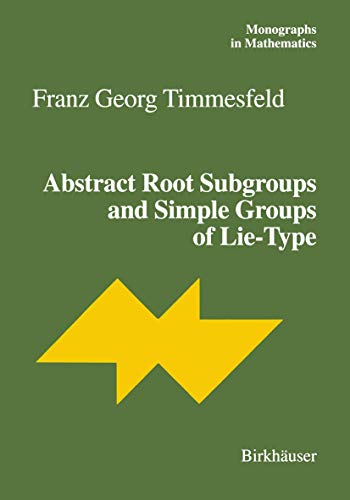Verwandte Artikel zu Abstract Root Subgroups and Simple Groups of Lie-Type:...

Inhaltsangabe
It was already in 1964 [Fis66] when B. Fischer raised the question: Which finite groups can be generated by a conjugacy class D of involutions, the product of any two of which has order 1, 2 or 37 Such a class D he called a class of 3-tmnspositions of G. This question is quite natural, since the class of transpositions of a symmetric group possesses this property. Namely the order of the product (ij)(kl) is 1, 2 or 3 according as {i,j} n {k,l} consists of 2,0 or 1 element. In fact, if I{i,j} n {k,I}1 = 1 and j = k, then (ij)(kl) is the 3-cycle (ijl). After the preliminary papers [Fis66] and [Fis64] he succeeded in [Fis71J, [Fis69] to classify all finite "nearly" simple groups generated by such a class of 3-transpositions, thereby discovering three new finite simple groups called M(22), M(23) and M(24). But even more important than his classification theorem was the fact that he originated a new method in the study of finite groups, which is called "internal geometric analysis" by D. Gorenstein in his book: Finite Simple Groups, an Introduction to their Classification. In fact D. Gorenstein writes that this method can be regarded as second in importance for the classification of finite simple groups only to the local group-theoretic analysis created by J. Thompson.
Die Inhaltsangabe kann sich auf eine andere Ausgabe dieses Titels beziehen.
Críticas
"The book is well written: the style is concise but not hard and most of the book is not too difficult to read for a graduate student. Some parts of it are certainly suited for a class."
--Mathematical Reviews
Reseña del editor
This book systematically treats the theory of groups generated by a conjugacy class of subgroups, satisfying certain generational properties on pairs of subgroups. For finite groups, this theory has been developed in the 1970s mainly by M. Aschbacher, B. Fischer and the author. It was extended to arbitrary groups in the 1990s by the author. The theory of abstract root subgroups is an important tool to study and classify simple classical and Lie-type groups.
„Über diesen Titel“ kann sich auf eine andere Ausgabe dieses Titels beziehen.
Neu kaufen
Diesen Artikel anzeigenGratis für den Versand innerhalb von/der Deutschland
Versandziele, Kosten & DauerSuchergebnisse für Abstract Root Subgroups and Simple Groups of Lie-Type:...
Abstract Root Subgroups and Simple Groups of Lie-Type
Anbieter: AHA-BUCH GmbH, Einbeck, Deutschland
Taschenbuch. Zustand: Neu. Druck auf Anfrage Neuware - Printed after ordering - It was already in 1964 [Fis66] when B. Fischer raised the question: Which finite groups can be generated by a conjugacy class D of involutions, the product of any two of which has order 1, 2 or 37 Such a class D he called a class of 3-tmnspositions of G. This question is quite natural, since the class of transpositions of a symmetric group possesses this property. Namely the order of the product (ij)(kl) is 1, 2 or 3 according as {i,j} n {k,l} consists of 2,0 or 1 element. In fact, if I{i,j} n {k,I}1 = 1 and j = k, then (ij)(kl) is the 3-cycle (ijl). After the preliminary papers [Fis66] and [Fis64] he succeeded in [Fis71J, [Fis69] to classify all finite 'nearly' simple groups generated by such a class of 3-transpositions, thereby discovering three new finite simple groups called M(22), M(23) and M(24). But even more important than his classification theorem was the fact that he originated a new method in the study of finite groups, which is called 'internal geometric analysis' by D. Gorenstein in his book: Finite Simple Groups, an Introduction to their Classification. In fact D. Gorenstein writes that this method can be regarded as second in importance for the classification of finite simple groups only to the local group-theoretic analysis created by J. Thompson. Artikel-Nr. 9783034875967
Anzahl: 1 verfügbar
Abstract Root Subgroups and Simple Groups of Lie-Type (Monographs in Mathematics)
Anbieter: Ria Christie Collections, Uxbridge, Vereinigtes Königreich
Zustand: New. In. Artikel-Nr. ria9783034875967_new
Anzahl: Mehr als 20 verfügbar
Abstract Root Subgroups and Simple Groups of Lie-Type (Monographs in Mathematics)
Anbieter: Revaluation Books, Exeter, Vereinigtes Königreich
Paperback. Zustand: Brand New. 2001 edition. 408 pages. 9.70x6.70x1.00 inches. In Stock. Artikel-Nr. x-3034875967
Anzahl: 2 verfügbar

